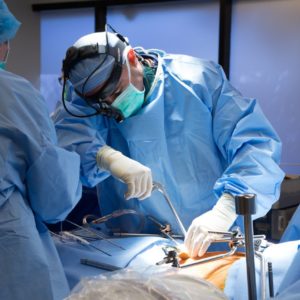 What Are Discs & What Do They Do?
What Are Discs & What Do They Do?
Between your spinal bones (vertebrae) are flexible, gel-like pads called “discs” (intervertebral discs) that give your spine its curves and flexibility (a curved, flexible spine is much stronger than a straight, rigid one). Discs affect your height too—you are about 4” – 2” taller when you wake up than when you go to sleep. Why? Because gravity thins your discs a little when you walk and sit during the day; discs expand a little while you lie in bed (that’s why astronauts gain about one inch in height due to weightlessness).
Research is revealing that spinal discs may be involved in some cases of lower back pain.1-3
Disc Protrusion & Prolapse
As you age, your discs may lose fluid and small cracks or lesions may form in the outer walls.4 This damage may also be caused or accelerated by the presence of subluxations, a distortion in your structural system that chiropractors correct. Your disc may bulge, irritate nerves and cause a lot of pain and discomfort. In severe cases disc damage may affect sitting, standing, walking or lifting and cause pain when urinating, defecating, sneezing and coughing. Numbness of the leg or foot or a loss of muscular control may also occur.
Do You Have A “Slipped” Disc?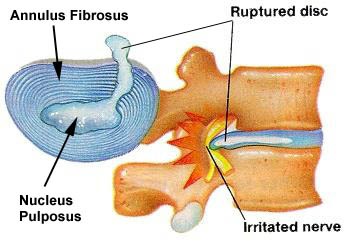
A disc cannot “slip” since it is knitted into the vertebrae from both above and below. What sometimes do slip are the vertebrae. Many “slipped” discs would be more accurately called slipped vertebrae or subluxations.
Organic Disease
Disc degeneration may lead to irritation of spinal nerves and contribute to endometriosis, infections (bladder, vaginal, kidney), urinary retention, prostate problems, miscarriage, sterility, impotence, cystitis, menstrual cramps and constipation. It is not uncommon for an individual with a back condition to also suffer from one or more of the above problems.5
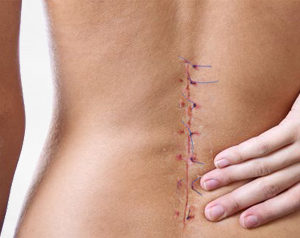 Is Back Surgery Effective?
Is Back Surgery Effective?
According to Robert Mendelsohn, MD, “I have seen more than one case in which spinal surgery was avoided by individuals who decided … to see a chiropractor….” Many have followed his advice to avoid back surgery.6
Back surgery for herniation should only be attempted as a last resort. That is because back surgery is a dangerous procedure with a high failure rate. In many people the disc is not causing pain; many people have disc degeneration with no symptoms! 7
The Chiropractic Record
For many years chiropractic has been able to save people from spinal surgery. There are reports of an MRI or other imaging device revealing a disc herniation or protrusion in the neck or low back which was reduced or completely reabsorbed under chiropractic care. Had they not sought out chiropractic, many of these individuals undoubtedly would have had surgery.8-13
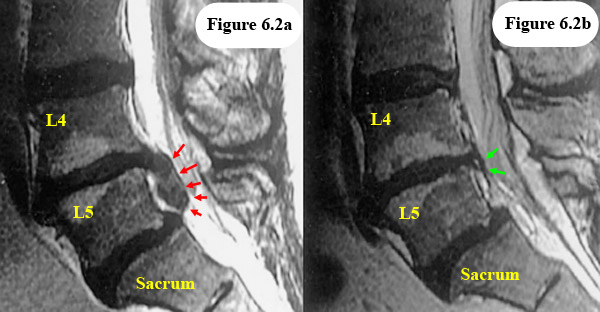 In one study 27 patients documented with disc herniation were given chiropractic care. Post-care MRIs revealed that 63% of the patients had a reduced or completely reabsorbed disc herniation and 78% returned to work.14
In one study 27 patients documented with disc herniation were given chiropractic care. Post-care MRIs revealed that 63% of the patients had a reduced or completely reabsorbed disc herniation and 78% returned to work.14
According to one research study most lumbar disc herniations improve over time with or without medical treatment. Disc herniations and annular tears may not be symptomatic and are shown to exist in patients without any symptoms.15
In another study of 517 patients with protruded lumbar discs, 76.8% had satisfactory results under chiropractic.16
Is Surgery Ever Needed?
Surgery is sometimes necessary, but it is an extreme form of healthcare and it has many dangers. Many times spinal surgery fails and must be repeated. It should only be considered after more natural, less invasive methods have been given a fair chance.17
How To Prevent Disc Problems
Chiropractic has been a blessing to many sufferers of spine and disc problems, yet chiropractic is not limited to back and disc problems; it is for your entire body. Many times patients visiting their chiropractor for a back or neck problem have been pleasantly surprised at the holistic or whole-body effect of chiropractic. Why wait until a disc becomes “hot” before exploring chiropractic care?
Chiropractic care may help prevent your spine from deterioration and herniation. Chiropractors have even helped people relieve the pain and frustration of failed back surgery (yes, you can receive chiropractic care if you’ve had spinal surgery) and even prevent future operations. Please, before your problems get worse, have a simple chiropractic spinal checkup. You get your eyes, teeth and blood pressure checked, why not your spine?
For an appointment at Performance Chiropractic, call us at (661) 942-5000.
References
- Bogduk N, Aprill C. On the nature of neck pain, discography and cervical zygapophyseal joint blocks. Pain. 1993;54:213-217.
2. Kuslich S et al. The tissue origin of low back pain and sciatica: a report of pain response to tissue stimulation during operations on the lumbar spine. Orthopedic Clinics of North America. 1991;22(2):181-187.
3. Carragee E et al. 2000 Volvo award winner in clinical studies: lumbar high intensity zones and discography in subjects without low back complaints. Spine. 2000;25(23):2987-2992.
4. Lundon K et al. Structure and function of the lumbar intervertebral disk in health, aging and pathologic conditions. JOSPT. 2001;31(6):291-303.
5. Browning JF. The mechanically induced pelvic pain and organic dysfunction syndrome: an often overlooked cause of bladder, bowel, gynecological, and sexual dysfunction. JNS. 1996;4:52-66.
6. Mendelsohn R. Malepractice: How Doctors Manipulate Women. Chicago: Contemporary Books, Inc., 1981.
7. Kalichman L, Kim DH, Li L, Guermazi A et al. Spondylolysis and spondylolisthesis: prevalence and association with low back pain in the adult community-based population. Spine. 2009;34(2):199-205.
8. Eriksen K. Management of cervical disc herniation with upper cervical chiropractic care. JMPT. 1998;21(1):51-56.
9. Murphy J et al. Improvement in a patient with disc protrusion and extruded fragment following subluxation based chiropractic care: a case study & selective review of the literature. AVSR. November 19, 2015:78.
10. Robinson GK. Reabsorption of a herniated cervical disc following chiropractic treatment utilizing the atlas orthogonal technique: a case report. Abstracts from the 14th Annual Upper Cervical Spine Conference, Nov. 22-23, 1997. Life University, Marietta, GA. Chiropractic Research J. 1998;5(1).
11. Santilli V et al. Chiropractic manipulation in the treatment of acute back pain and sciatica with disc protrusion: a randomized double blind clinical trial of active and simulated spinal manipulations. Spine. 2006;6(2):131-137.
12. Legorreta AP, Metz RD, Nelson CF et al. Comparative analysis of individuals with and without chiropractic coverage: patient characteristics, utilization, and costs. Arch Intern Med. 2004;164:1985-1992.
13. Excoffon SG, Wallace H. Chiropractic and rehabilitative management of a patient with progressive lumbar disk injury, spondylolisthesis, and spondyloptosis. J Manipulative Physiol Ther. 2006;29(1):66-71.
14. Ben Eliyahu DJ. Magnetic resonance imaging and clinical follow-up: study of 27 patients receiving chiropractic care for cervical and lumbar disc herniations. JMPT. 1996;19(19):597-606.
15. Simon J, McAuliffe M, Shamim F, Vuong N, Tahaei A. Discogenic low back pain. Phys Med Rehabil Clin N Am. 2014;25(2):305-317.
16. Pang-Fu Kuo P, Loh Z. Treatment of lumbar intervertebral disc protrusions by manipulation. Clinical Orthopedics and Related Research. 1987;215:47-55.
17. Legrand E, Bouvard B, Audran M et al. Sciatica from disk herniation: medical treatment or surgery? Joint Bone Spine. 2007;74(6):530-535.
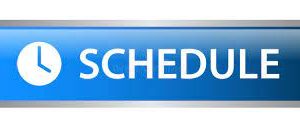

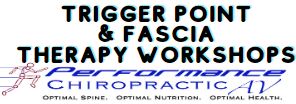

FOLLOW US!